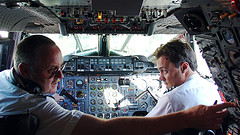If you want to become a pilot, you need to pass a medical screening including color vision—usually by taking a simple color blindness test. Even if you already received your pilots license, you have to go to a medical check up every 12 month, again including a color vision deficiency test.
 What are your choices to accomplish the FAA test for color vision—specially if this could be a problem for you as you know you don’t have perfect color vision? This article will show you the different possibilities you have to master this specific test on color vision deficiency.
What are your choices to accomplish the FAA test for color vision—specially if this could be a problem for you as you know you don’t have perfect color vision? This article will show you the different possibilities you have to master this specific test on color vision deficiency.
There are two ways you can go to accomplish it. The first choice is always to take a usual color blindness test with your Aviation Medical Examiner (AME). If you can’t pass this first round there is the possibility of retesting using some other color vision deficiency test which is accepted by the FAA. Or you can choose the second way which includes some special form of a very job specific color vision testing. But be prepared because this specific test can only be taken once and thereafter there is no other color vision test allowed anymore!
Let me explain this step by step in more detail.
First way: Accepted Color Blindness Tests
Any of the following listed tests can be taken to examine your color vision. If you fail one of them there is always the possibility to take another test of the list. I think this is a good rule as you can always have a bad day or be to nervous. So make sure that you pass in the second round. And it is important to know, that no other color blindness tests are allowed!
- Pseudoisochromatic Plates Color Vision Tests: This tests are the most common ones and also known as Ishihara plates tests, because the first and very well known plates were made by Dr. Shinobu Ishihara. It is reported that the AOC and the Dvorine tests are the easiest to accomplish for people with color vision deficiency.
- AOC (1965 edition)
- AOC-HRR (second edition)
- Dvorine pseudoisochromatic plates (second edition, 15 plates)
- Ishihara pseudoisochromatic plates (concise 14-plate edition, 24-plate edition, 38-plate edition)
- Richmond pseudoisochromatic plates (1983 edition)
- Richmond-HRR (4th edition)
- Tools which display plates: Titmus Vision Tester, Titmus II Vision Tester, Titmus 2 Vision Tester, Titmus i400, OPTEC 2000 Vision Tester, OPTEC 900 Vision Tester, Keystone Orthoscope, or Keystone Telebinocular
- Electronically plates by LEDs: APT-5 Color Vision Tester
- Farnsworth Lantern Test (FALANT): This is the only test allowed which is not based on isochromatic plates. The FALANT test consist of two little lights showing one of the colors red, green, or white which have to be named correctly. It is reported to be the easiest test to accomplish.
For detailed information about the allowed number of errors in each test check the decision considerations for AMEs at the official FAA website.
Many people ask if it is allowed using color correcting lenses or glasses while taking a color vision test. Unfortunately the rules say clearly, that you are not granted to do so.
Second Way: Specialized Operational Medical Tests
If you fail the above tests and still want to try to get your license, there is a last chance for you. But it is very important to know, that this second possibility of test can only be done once and after that you are not allowed to take any other test again. So this is really your last chance!
The specialized operational medical test consists of five different test steps. The first two parts are subsumed under the name Operational Color Perception Test (OCVT) and you have to accomplish them during day light. The last three steps are called Medical Flight Test (MFT) including also in-flight testing.
- Signal Light Test (SLT): Identify in a timely manner aviation red, green, and white.
- Aeronautical chart reading: Read and correctly interpret in a timely manner aeronautical charts, including print in various sizes, colors, and typefaces; conventional markings in several colors; and, terrain colors.
- Read and correctly interpret in a timely manner aviation instruments or displays.
- Recognize terrain and obstructions in a timely manner.
- Visually identify in a timely manner the location, color, and significance of aeronautical lights such as, but not limited to, lights of other aircraft in the vicinity, runway lighting systems, etc.
Make sure you are fit while taking this test, as it can be taken only once. But if you can master it you will receive a Letter of Evidence (LOE) which means, you will never have to take a color blindness test again during your pilots career.
If you fail the color vision testing during your medical exam you will have the restriction of not valid for night flying or by color signal control.
There is also an interesting study about Unreliable Secondary Color Vision Tests for Pilot Candidates and you can also find a lot more information on this topic at Leftseat.com.
